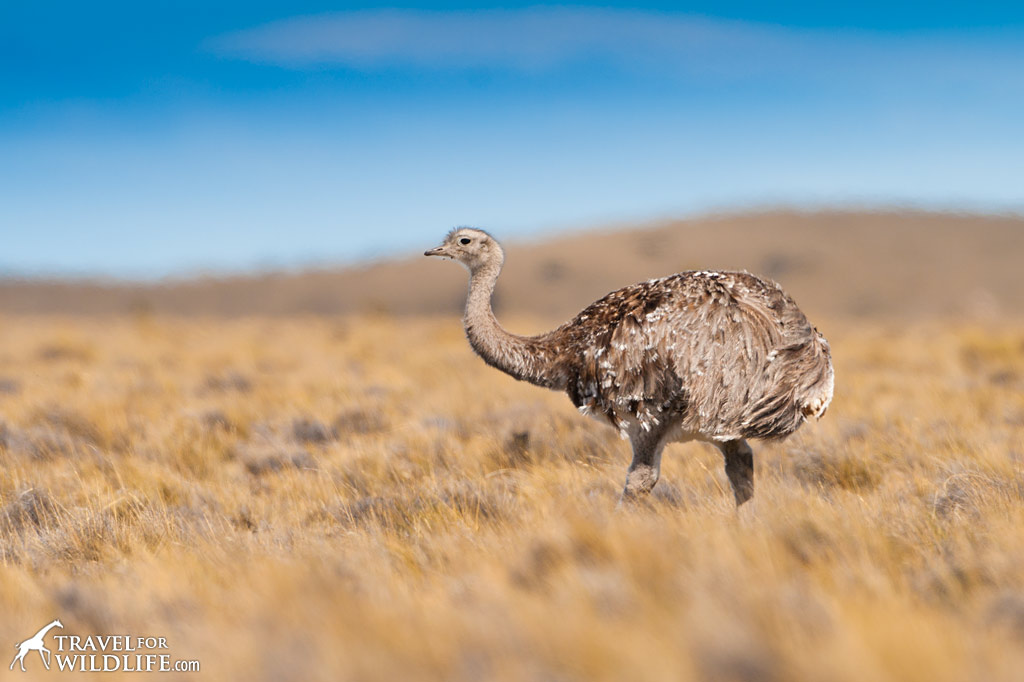Patagonia attracts thousands of visitors every year looking for guanacos, pumas, and glaciers. But the birds of Patagonia are equally impressive! Here’s a list of 32 Patagonian birds that you might spot during your travels. But first, a short introduction to birding hotspots in Patagonia.
The diversity of habitats in Torres del Paine National Park, in Chilean Patagonia, is home to over 100 bird species including 15 birds of prey. Torres del Paine and the environs have four types of vegetation – pre-Andean scrubland on the banks of rivers and lakes, beech forests, Magallanes tundra, and high-altitude vegetation which disappears as the altitude increases.
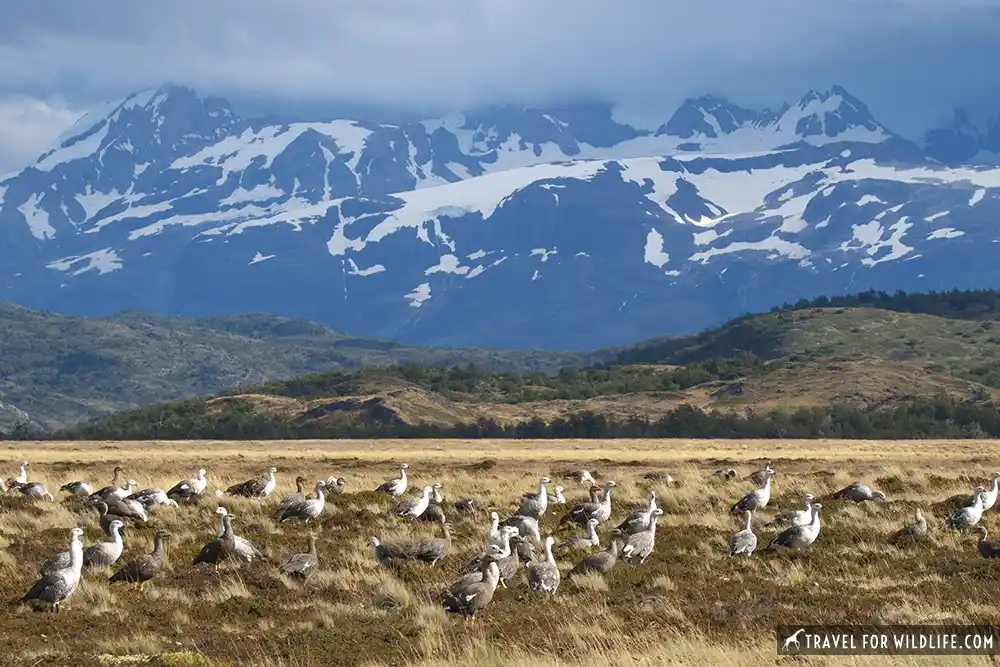
This array of habitats supports a wide variety of wildlife. From condors to rheas and pelicans to flamingos, this national park offers many opportunities for bird watchers.
Next door to the popular town of Ushuaia, Tierra del Fuego National Park, in Argentine Patagonia, is famous for its coastline, waterways, and forests. With over 220 species of birds, this national park is a must-see when visiting the southernmost tip of South America.
Ushuaia, the port where boats to Antarctica depart, is also a great place to watch seabirds or take a boat tour to see penguins.
Another place worth mentioning is Bahía Inútil, a bay a few hours north of Ushuaia. A few years ago a few king penguins visited. They came back the next year and decided to settle and form a small colony. You can visit the colony of this penguin species on a birding tour (more info below).
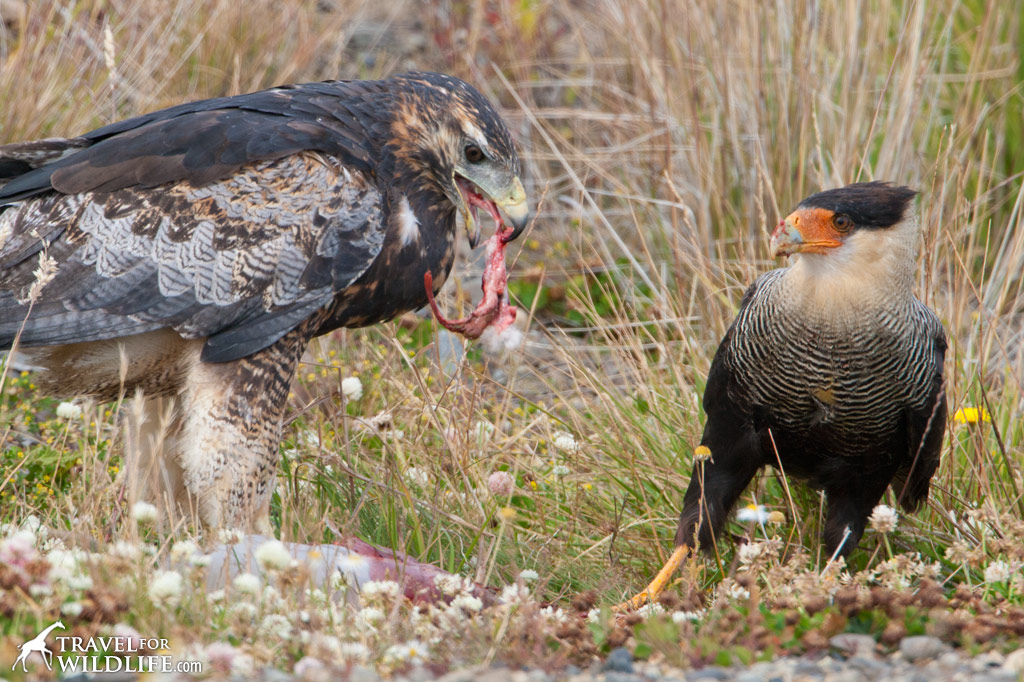
*This article may contain affiliate links. We receive a small commission at no extra cost to you.*
Birdwatching tours in Patagonia
- Birdwatching tour in Tierra del Fuego NP: spot Austral parakeet, Austral pygmy-Owl, Magellanic woodpecker, Thorn-tailed rayadito, black-necked swan, great grebe, upland goose, Andean condor, Magellanic and blackish oystercatcher, and kelp goose amongst others.
- Boat trip to Penguin colony from Ushuaia: birds seen are Magellanic penguins, imperial cormorants and rock cormorants, skuas, black-browed albatross, steamer ducks, cauquenes, Cook seagulls and gray seagulls.
- Magellanic penguin colony at Puerto Madryn tour. Walk along the penguin colony and see penguins at eye level.
- Magellanic penguin colony at Isla Martillo from a boat and canoeing on the Beagle Channel day adventure.
- Andean condor tour at Cerro Palomares from Punta Arenas
- Andean condor tour at Coyhaique, Chile
- King Penguin tour at Bahía Inútil, from Punta Arenas
Get your flights to Argentina here.
Get your flights to Chile here.
Recommended Patagonia bird guides
- Birds of Argentina and the Southwest Atlantic, Princeton Field Guides, 128 by Mark Pearman, Juan Ignacio Areta, and others.
- Birds of Southern South America and Antarctica, by Martín R. de la Peña, Maurice Rumbell, and others.
- Birds of Patagonia, Tierra del Fuego, and Antarctic Peninsula: The Falkland Islands and South Georgia by Enrique Couve and C. Vidal
32 Birds of Patagonia
Southern-crested caracara
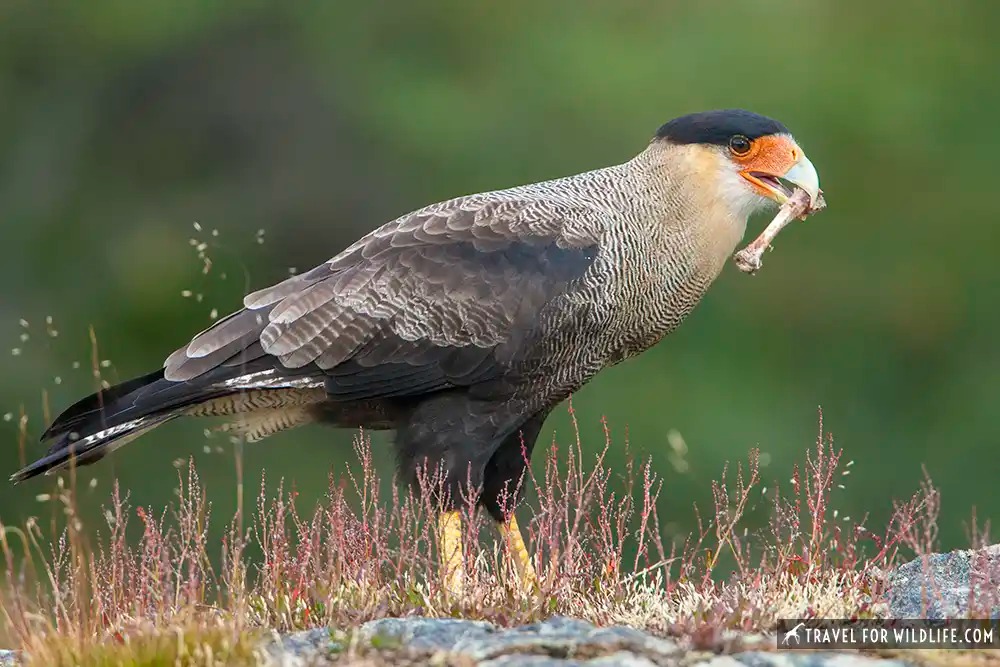
The Crested caracara (Caracara plancus) is found in open and semi-open habitats from Tierra del Fuego NP in Patagonia to southern Peru. Feeds on carcasses, but will also take small birds.
Where to see Crested caracara: Torres del Paine NP, Tierra del Fuego NP, Puerto Natales area.
Black-chested Buzzard-eagle
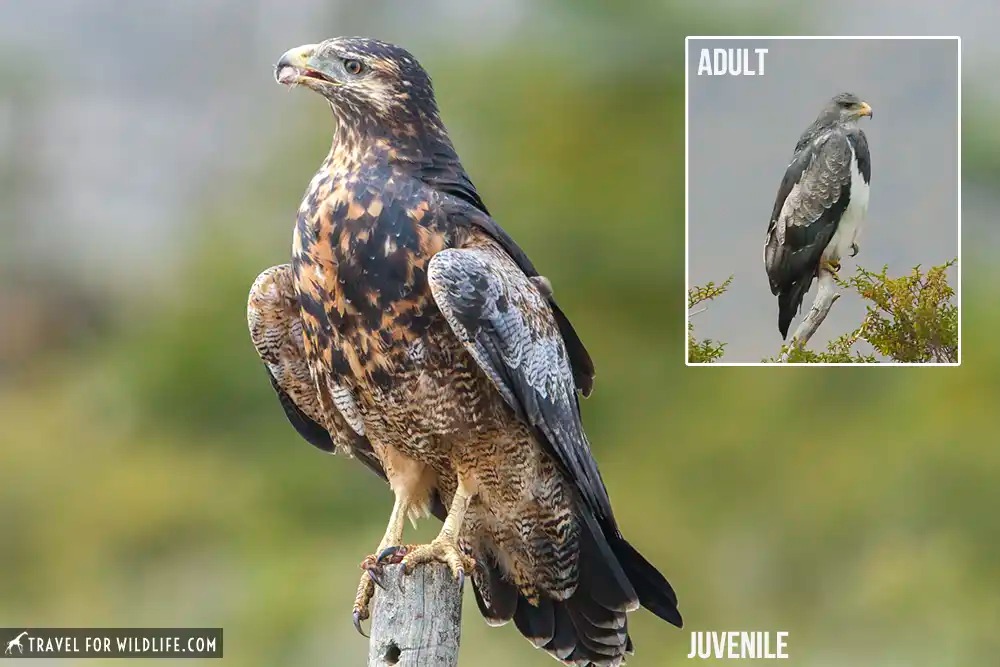
The black-chested buzzard eagle (Geranoaetus melanoleucus) is a powerful-built raptor that lives at high altitudes in mountain ranges. Only adults present the black chest and white belly that are so characteristic of this species, while juveniles are more of a mottled-brown color.
Where to see the black-chested buzzard eagle: Torres del Paine NP, Puerto Natales area
Chilean flamingos (Phoenicopterus chilensis) are found in Patagonia’s salt lakes, estuaries, and lagoons. Compared to the American flamingo, the Chilean flamingo’s head and neck are lighter colored, and their bills have a larger amount of black.
Where to see them: Laguna Azul and Laguna Amarga in Torres del Paine NP
Magellanic penguin
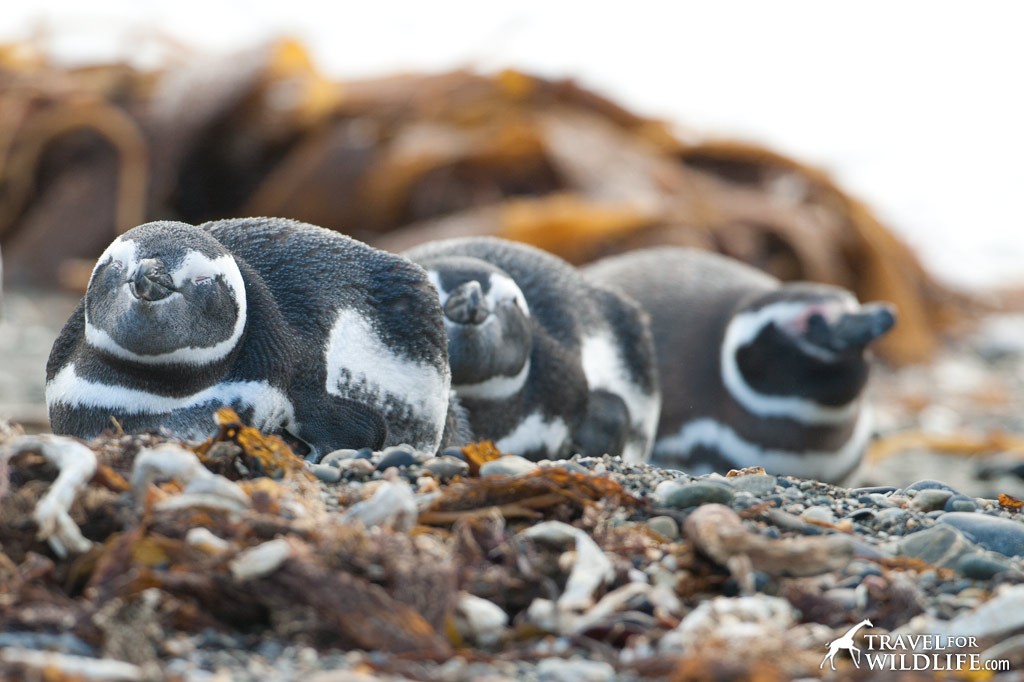
You don’t have to go to Antarctica to see penguins. The Magellanic penguin (Spheniscus magellanicus) breeds as far north as Caleta Valdés (Valdés peninsula) and the largest colony of Magellanic penguins in South America is found 115 miles north of Puerto Madryn, in Punta Tombo National Reserve.
Where to see penguins in Patagonia: Seno Otway, Martillo Island, Punta Tombo National Reserve (Puerto Madryn)
You won’t find the lesser rhea (Rhea pennata) up in the sky as this is an entirely flightless bird. Think ostrich but smaller. Also known as Darwin’s Rhea, it is found in the Patagonian steppes or grasslands. They spread their wings when running. Those rhea living on the Patagonian Steppe are known as Lesser Rhea.
Where to see lesser rhea: Torres del Paine NP
The Austral parakeet (Enicognathus ferrugineus) is the southernmost parrot in the world. Found from Tierra del Fuego in the south to as far north as Temuco. This parrot is primarily green, lightly barred, with some dull red on the forehead, belly, and upper tail.
Where to see the Austral Parakeet: Tierra del Fuego NP, Torres del Paine NP
Dark-bellied Cinclodes
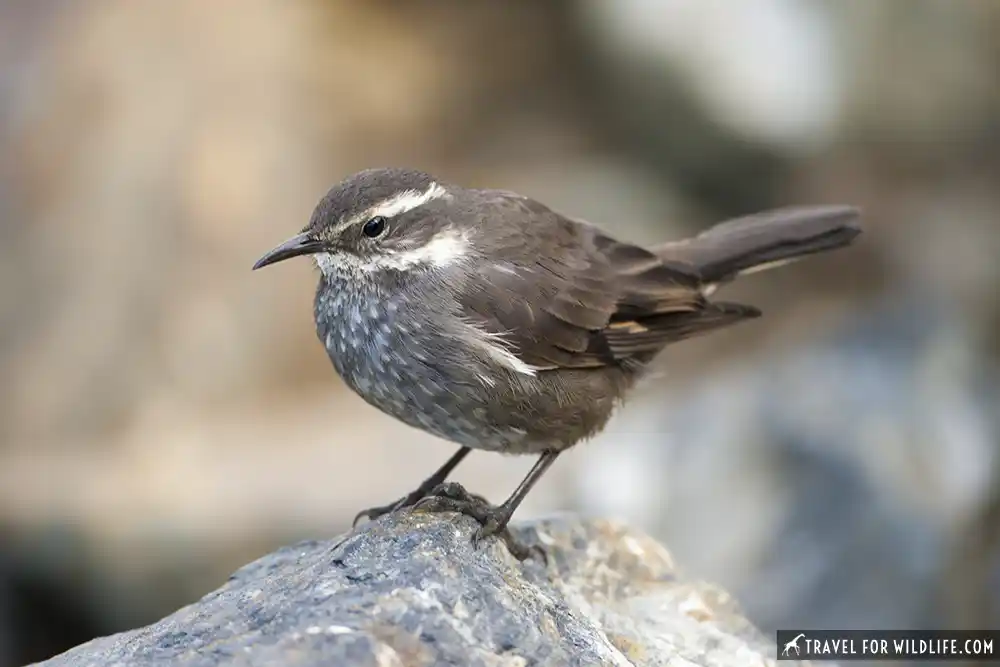
The dark-bellied cinclodes (Cinclodes patagonicus) is found in the western southern tip of South America, from Valparaiso to Ushuaia. In the northern parts of its range, it can be found at altitudes up to 8,200 ft, and in the southern part, they are found at lower altitudes. They are normally found near the water on riverbanks, coastlines, lakes, and streams.
Where to see the dark-bellied cinclodes: Tierra del Fuego National Park
Dolphin Gull
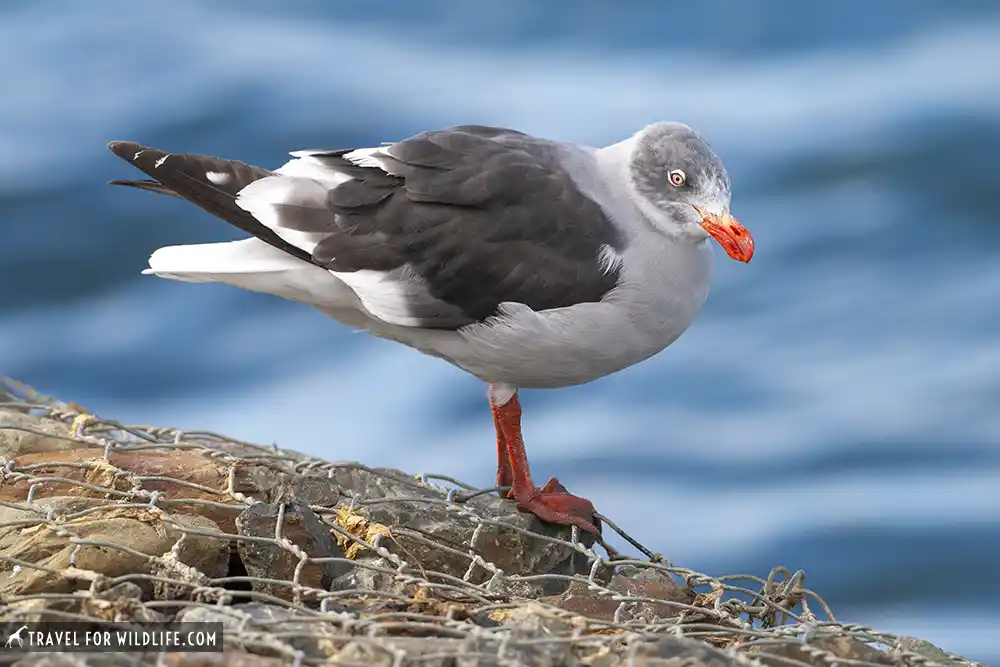
The dolphin gull (Leucophaeus scoresbii/ Larus scoresbii)is native to southern Chile and Argentina and the Falkland Islands. Likes rocky shores and seabird colonies, but is also found in lakes near the coast. Can be identified by their grey body and their red bill and red legs.
Where to see dolphin gulls: Fairly easy to spot around the Ushuaia coast.
Austral Pygmy Owl
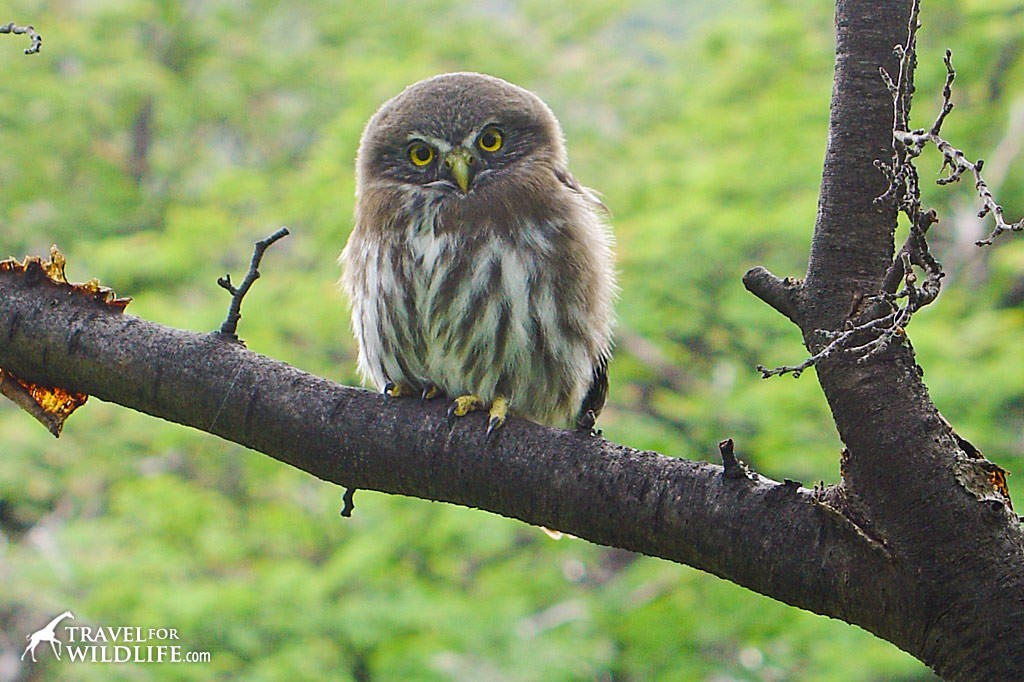
The Austral Pygmy owl (Glaucidium nana) is the smallest owl in Patagonia. These tiny owls inhabit the temperate forests of Patagonia and it’s easier to spot them during the day perched on low branches. From these perches they hunt for reptiles, small birds, insects, and small mammals.
Where to see them: Torres del Paine NP, Tierra del Fuego NP
Andean Condor
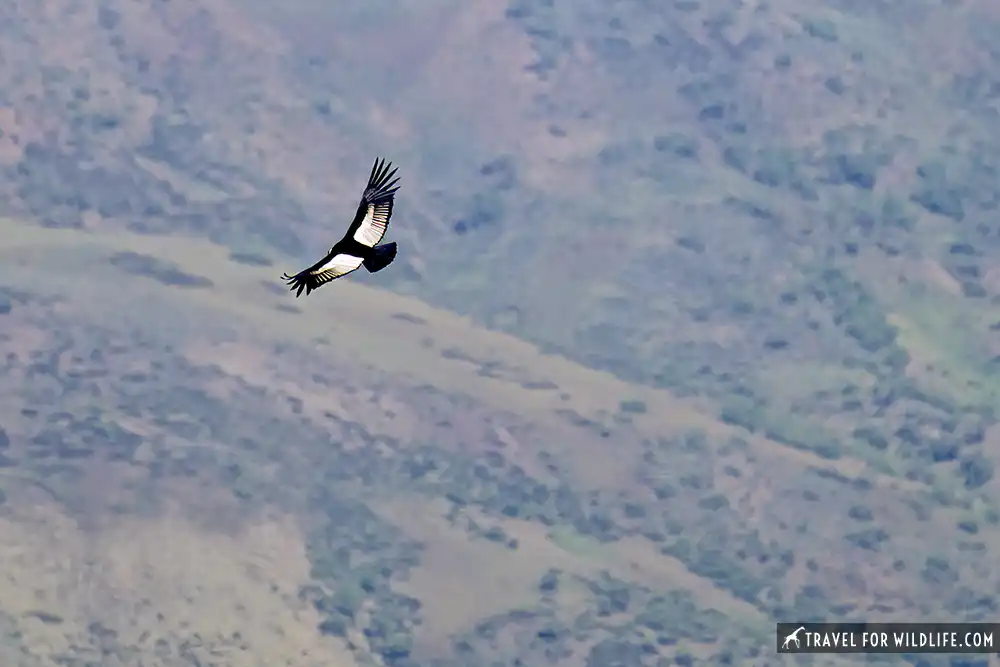
On the wishlist of all nature enthusiasts that visit Patagonia, the Andean condor (Vultures gryphon) has one of the biggest wingspans of any bird in the world: 10.5 feet! They are indeed one of the largest flying birds. The Andean condor soars through the sky like a glider, and catching a glimpse of this bird in places like Torres del Paine is an incredible sight.
The Andean condor is the national bird of Chile, Bolivia, Colombia, and Ecuador.
Where to see Andean condors in Patagonia: Cerro Palomares, Coyhaique, Torres del Paine National Park
Rock Cormorant
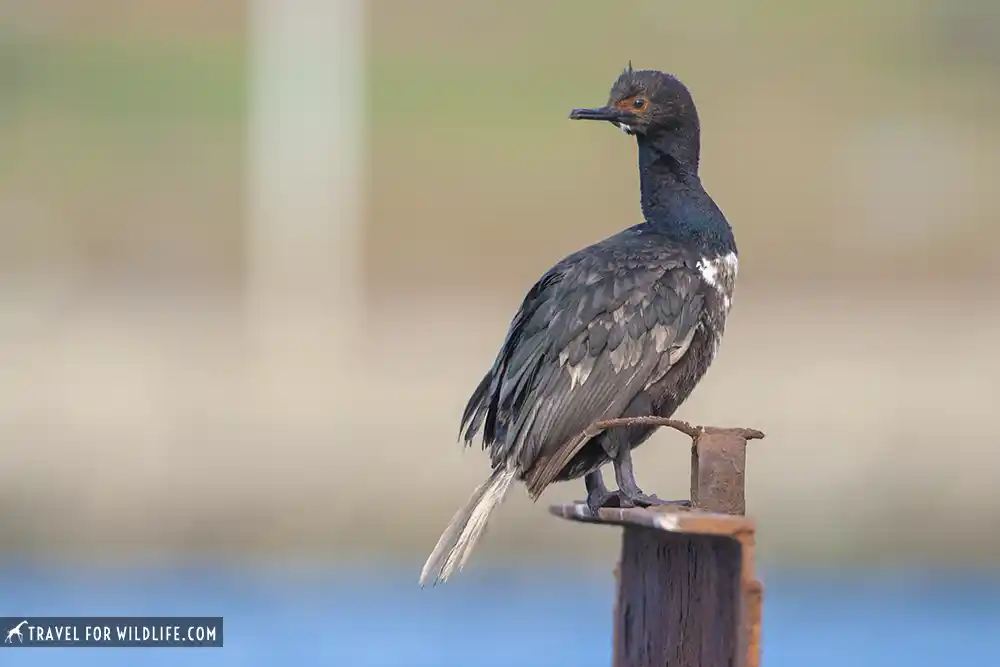
The rock cormorant (Phalacrocorax magellanicus) is a small cormorant found along rocky coastlines. They build their nests out of aquatic vegetation (like seaweed) in November, and the chicks don’t fledge until January/February, so this is a good time to spot them while they tend to their offspring.
Where to see rock cormorants: Easy to spot along Ushuaia and Tierra del Fuego NP
Kelp Goose
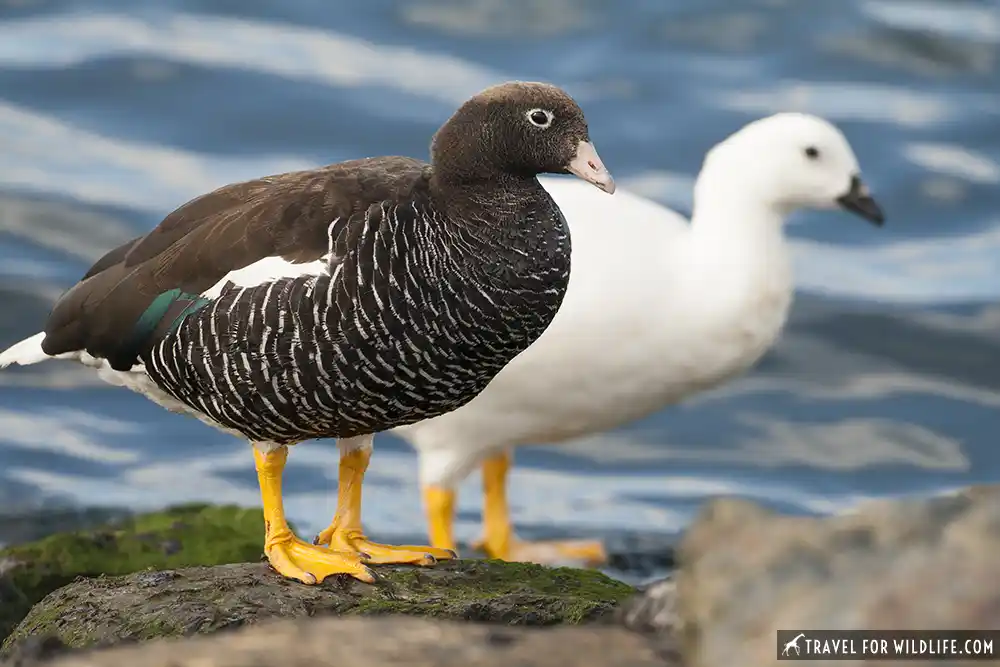
Found in coastal areas the kelp goose (Chloephaga hybrida) is easily identifiable because the male is pure white while the female is brown with white barring and a white tail.
Where to see kelp goose: Coast around Ushuaia, Tierra del Fuego
Kelp Gull
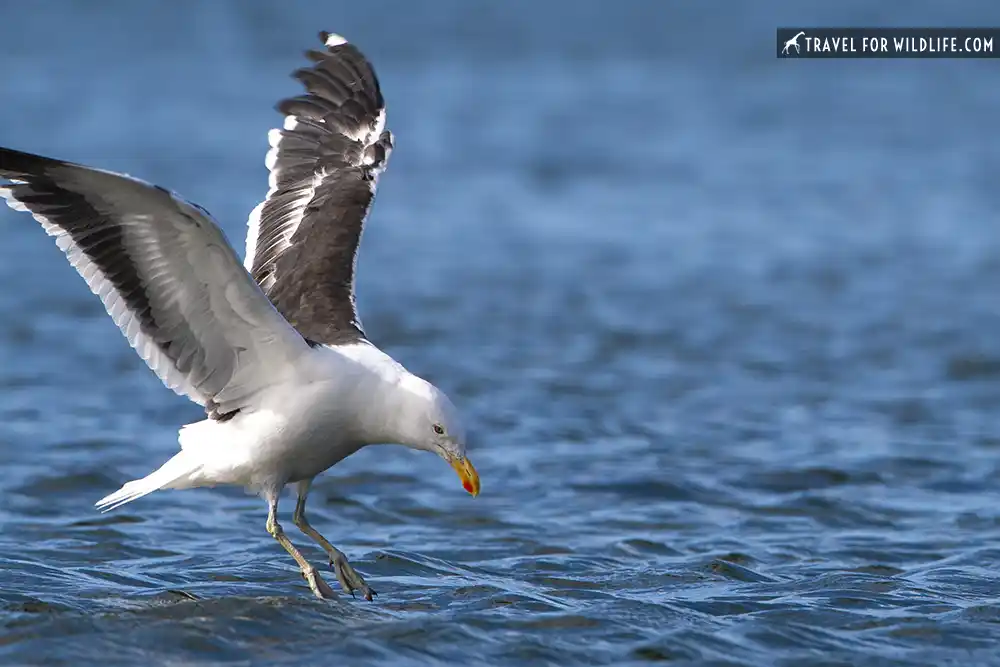
The kelp gull (Larus dominicanus) is common in the Southern Hemisphere and is found as far south as Antarctica. Adult kelp gulls have black backs, and wings with little white. They are omnivorous and they will use their powerful beaks to harass right whales and feed on pieces of blubber and skin of live whales, a behavior observed in Peninsula Valdés.
Where to see the kelp gull: Tierra del Fuego NP
Southern Lapwing
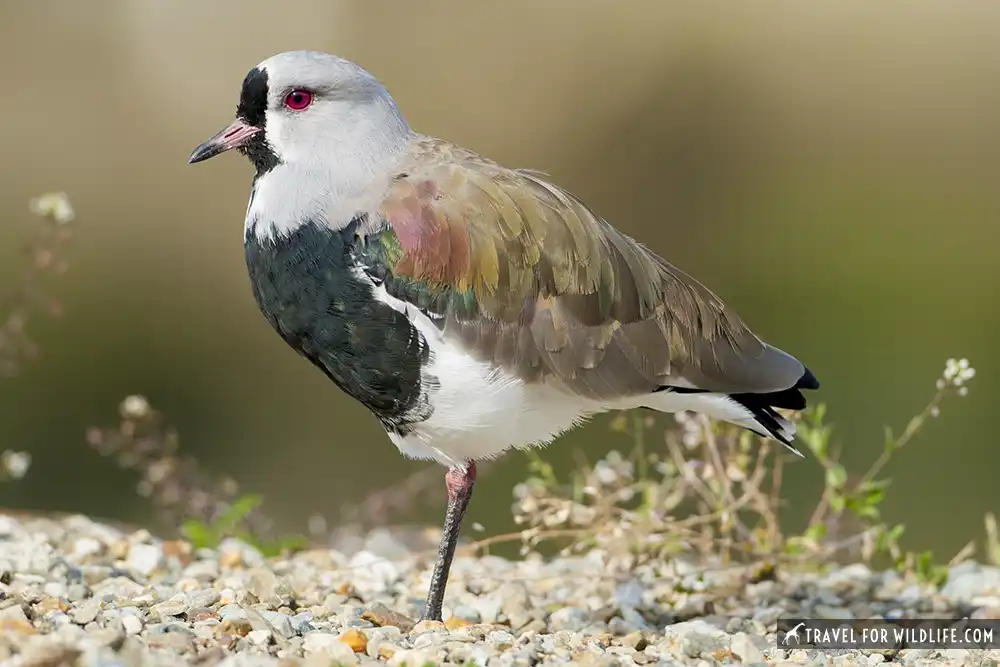
The gorgeous Southern lapwing (Vanellus chilensis) is the only crested wader in South America. Identifiable by its pattern and colors, has a white belly, black breast, gray head, and bronzy and green shoulder. They are found in small flocks in open habitats near water.
Where to see Southern lapwings: Ushuaia, Tierra del Fuego, Torres del Paine
Upland Goose
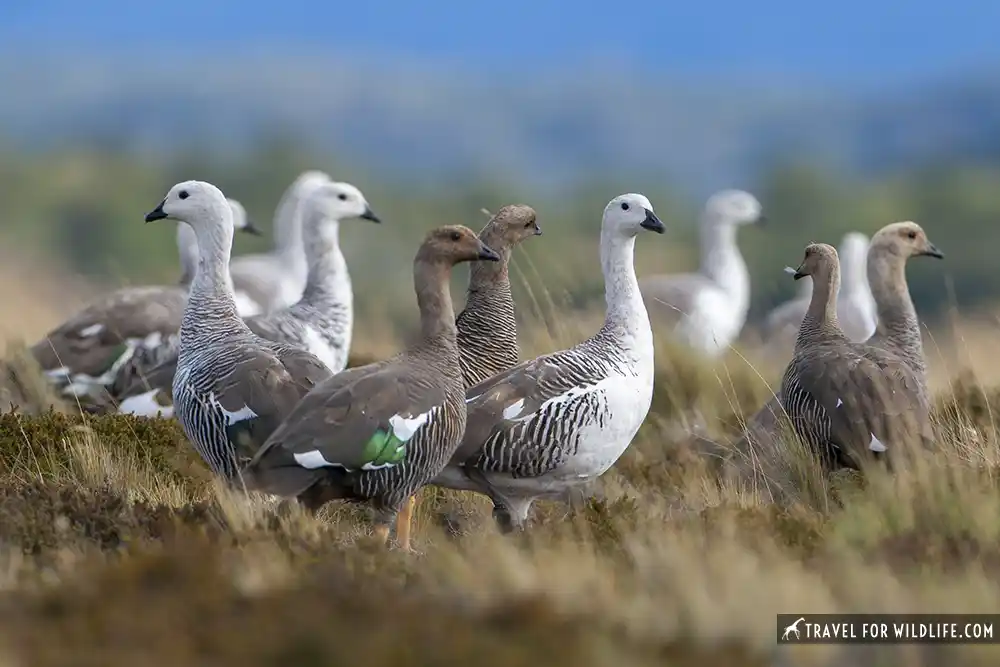
The upland goose (Chloephaga picta) is found on Patagonian steppe grasslands, lakes, wetlands, and coastal areas. The male has a white head, neck and breast, while the rest of the body is mostly barred. Females are brown with a barred chest. They nest near water and prefer to sleep in lakes where they are safe from predators.
Where to see upland geese: Grasslands around Torres del Paine National Park
Ashy-headed Goose
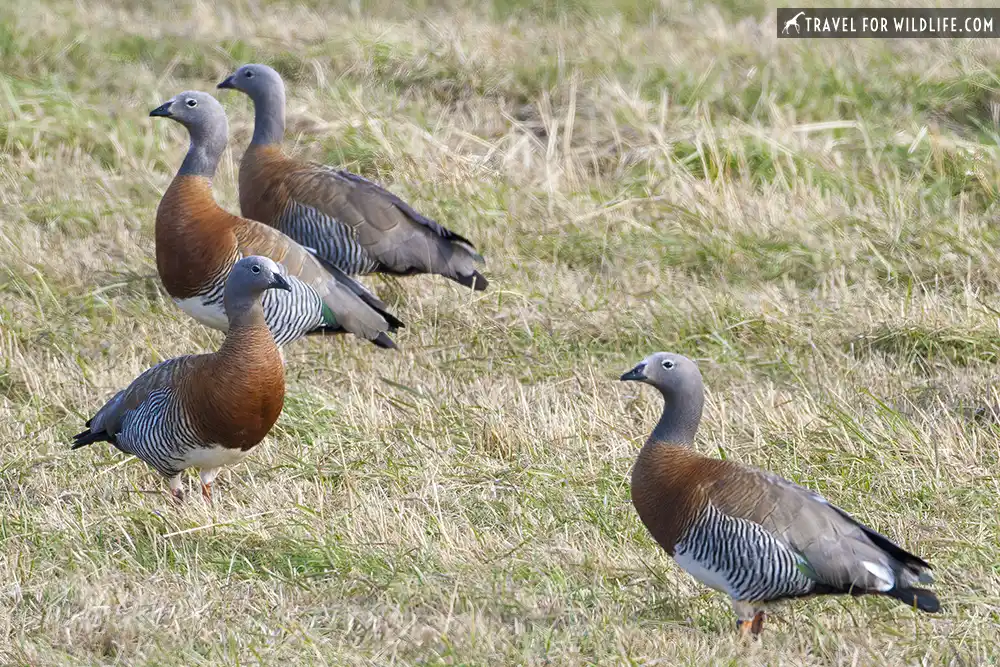
The ashy-headed goose (Chloephaga poliocephala) can be found in lakes and wetlands around forested areas. They are often found in small groups with other groups of upland geese. Males and females look alike.
Where to see ashy-headed geese: Tierra del Fuego National Park
Cinereous Harrier
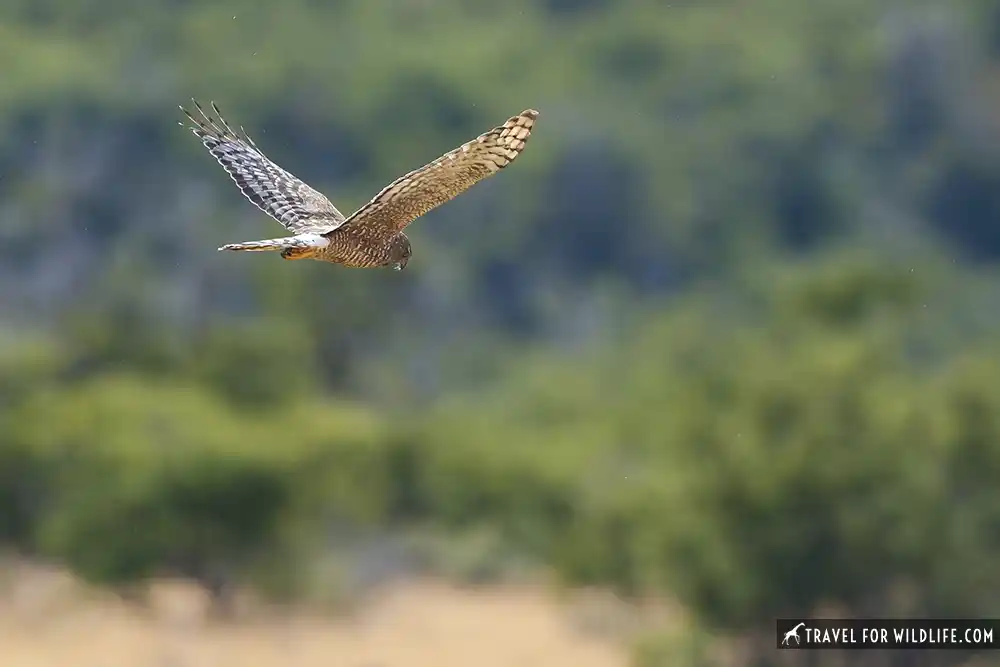
Common in open habitats, the cinereous harrier (Circus cinereous) can be found perched on posts or on the ground all over its range from the Andean Altiplano to lowland marshes. This bird of prey nests on the ground, usually on clumps of tall grass or reeds.
Where to see cinereous harriers: Torres del Paine National Park, Tierra del Fuego
Black-faced Ibis
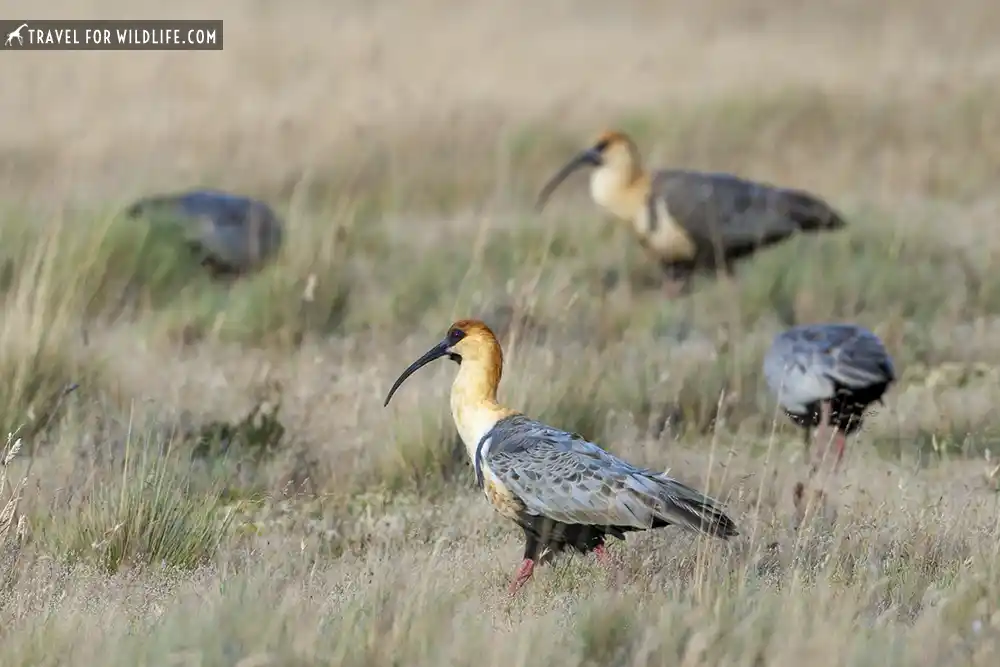
Often heard before being seen, the black-faced ibis (Theristicus melanopis) is a common bird in the grasslands of Patagonia. Foraging on the ground, they can be spotted in groups while hunting. The black-faced ibis roosts on trees and cliffs.
Where to see black-faced ibis: Torres del Paine NP
Chiloe (Southern) Wigeon
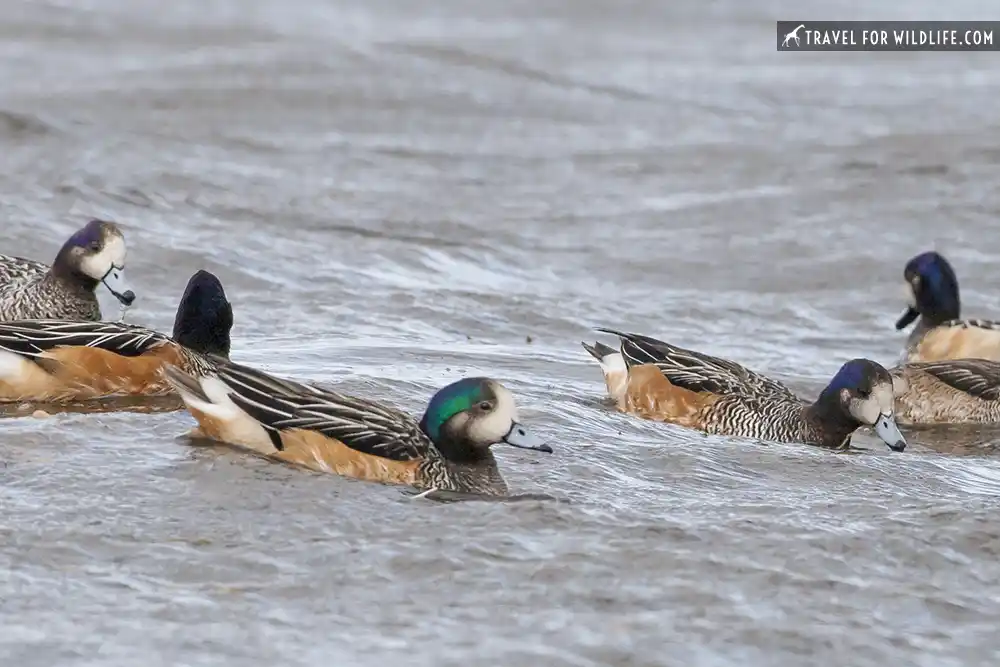
This gorgeous duck is often seen on grassy areas near the shore. The Chiloé wigeon (Anas sibilatrix) has striking head colors with an iridescent green-blue-teal cap, pale face, and a blueish bill with a black tip.
Where to see the Chiloé (southern) wigeon: Last Hope Sound near Puerto Natales, Tierra del Fuego.
Black-necked Swan
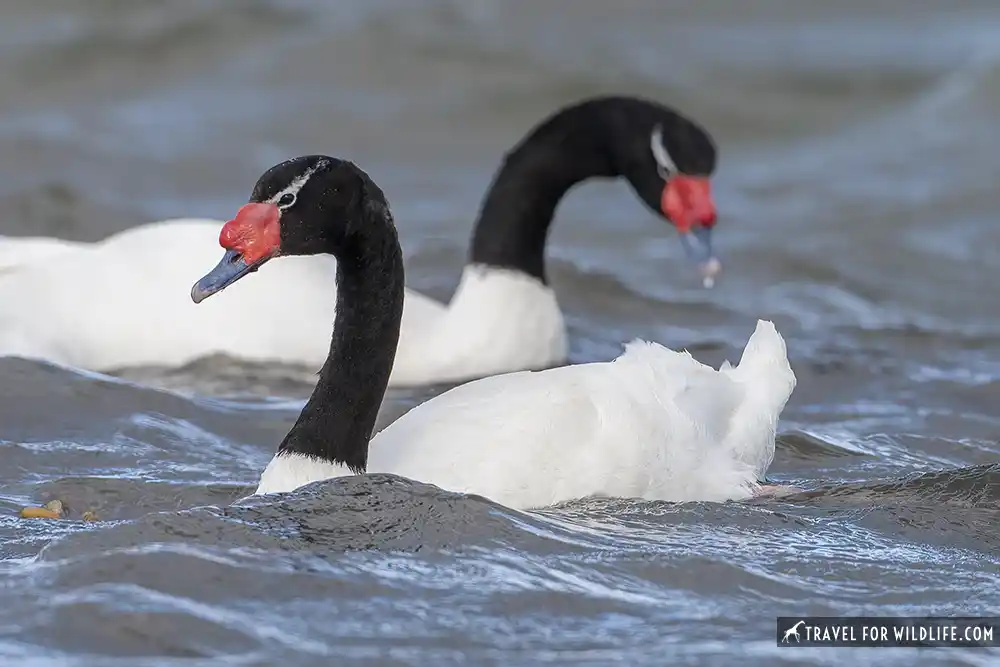
Black-necked swans (Cygnus melancoryphus) can measure up to 4.5 feet and are migratory, flying north in winter to warmer climates. These beautiful birds are easily identified by their white body and black neck. Cygnets are born white.
Where to see black-necked swans: Last Hope Sound in Puerto Natales.
Imperial Cormorant
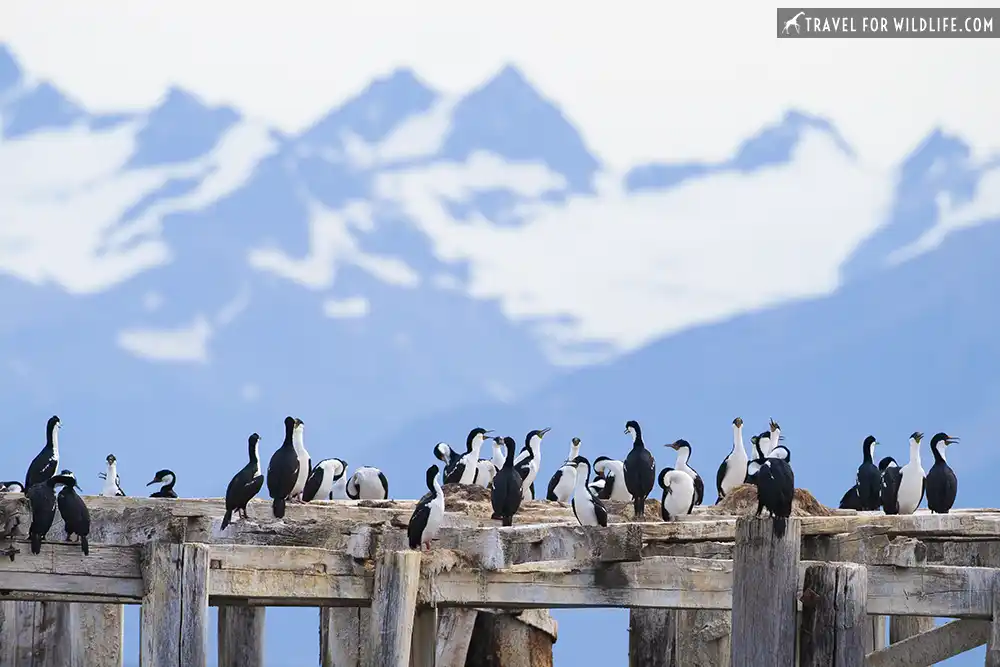
Found on coastal water in southern Patagonia, the imperial cormorant (Leucocarbo atriceps) is often found on piers, seawalls, and rocks. Their plumage varies regionally with some having more white on their heads and cheeks, and some having more black (like the subspecies known as the king cormorant). They all have white bellies and black backs and wings. Also known as the imperial shag.
Where to see Imperial cormorants: Isla de los Leones, Last Hope Sound (Seno Ultimo Esperanza) by Puerto Fatales.
Yellow-billed pintail
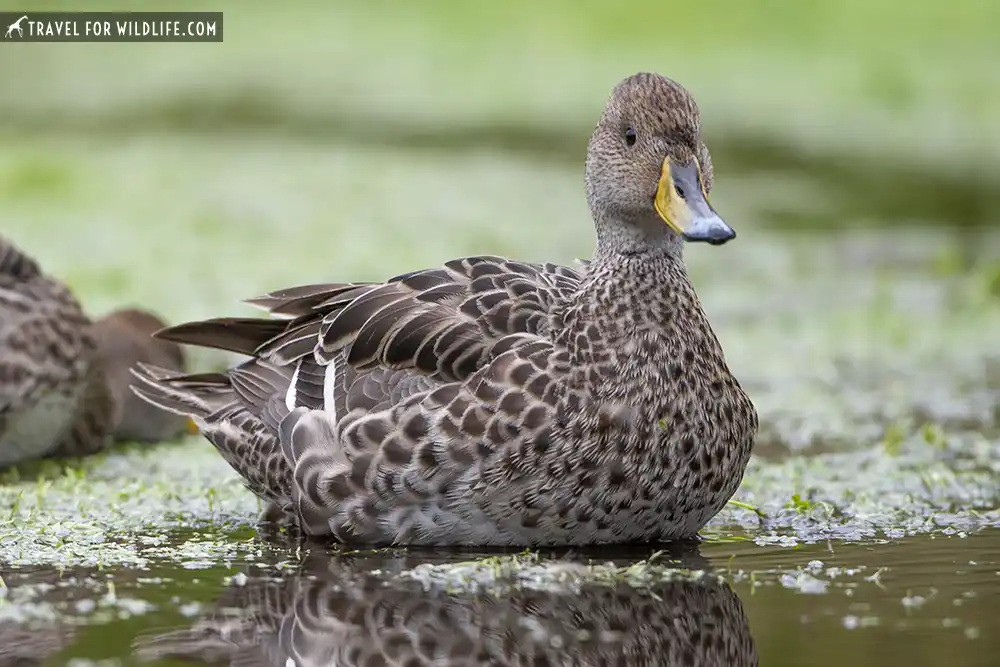
The yellow-billed pintail (Anas georgica) is a common sight around lakes and wetlands. Similar to yellow-billed teals, pintails are larger and with dark-mottled sides.
Where to see yellow-billed pintails: Tierra del Fuego NP
Yellow-billed teal
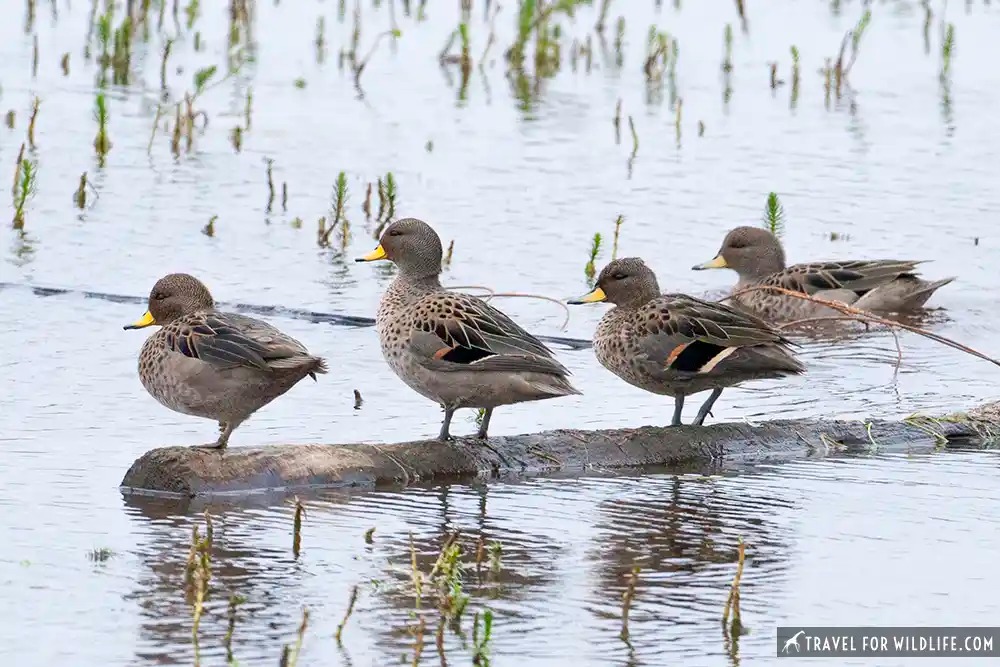
Yellow-billed teal (Anas flavirostris) is easily misidentified as yellow-billed pintail. The teal is smaller and with grey sides, while the pintail has mottled sides (see previous bird description)
Where to see yellow-billed teals: Tierra del Fuego NP
Coscoroba Swan
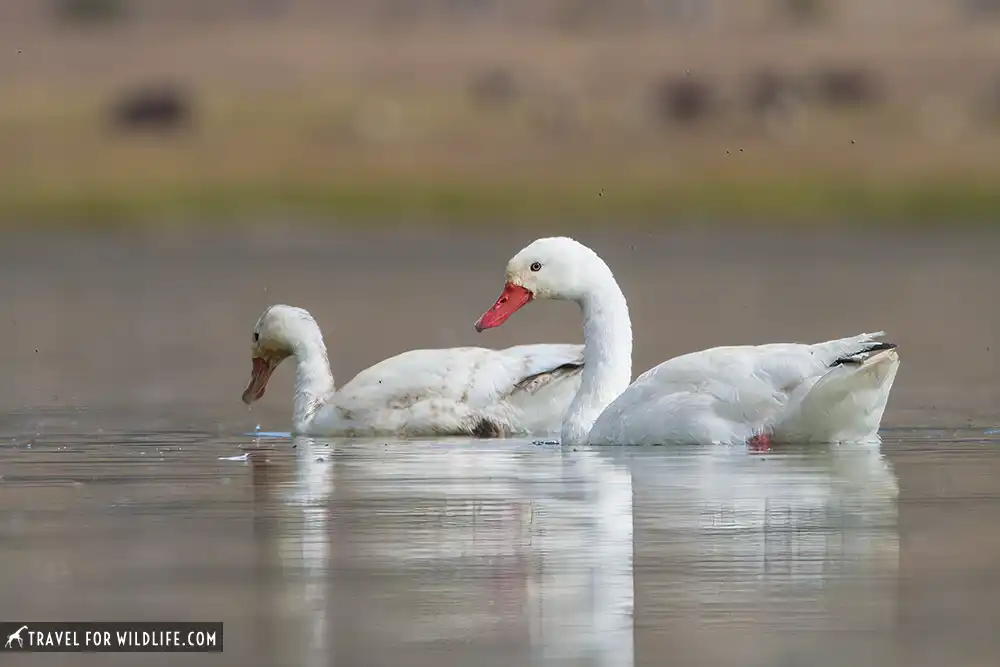
The Coscoroba swan (Coscoroba coscoroba) is sometimes found with black-necked swans. The Coscoroba swan is white with black wingtips, which are only visible when in flight.
Where to see coscoroba swans: Tierra del Fuego NP, Cerro Castillo NP
Austral Blackbird
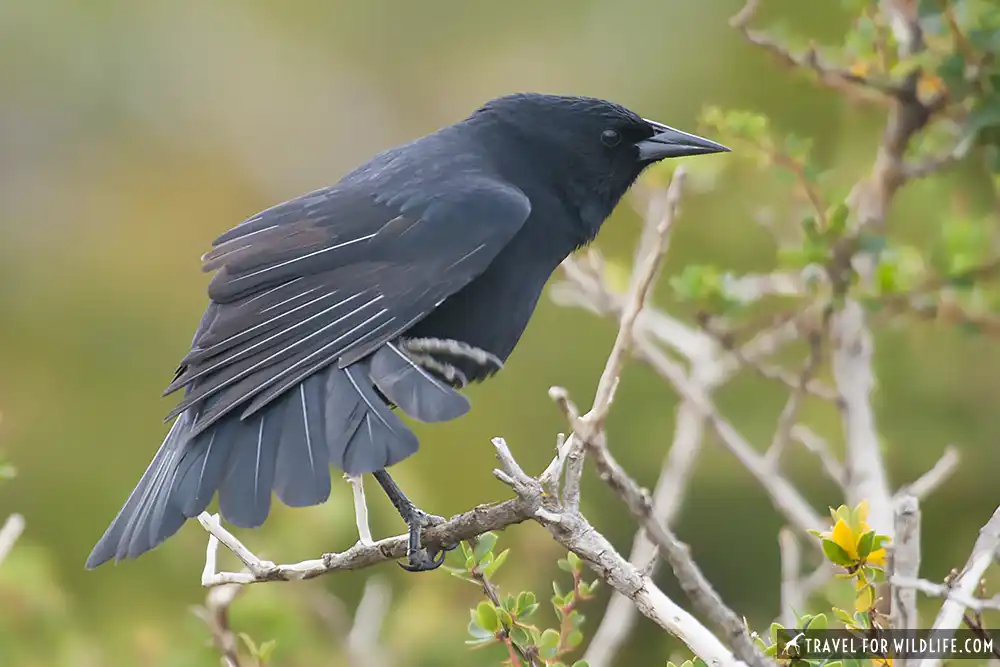
The Austral blackbird (Curaeus curaeus) can be found in small flocks at the edges of beech forests and around shrubland.
Where to see Austral blackbirds: Torres del Paine NP
Chilean Flicker
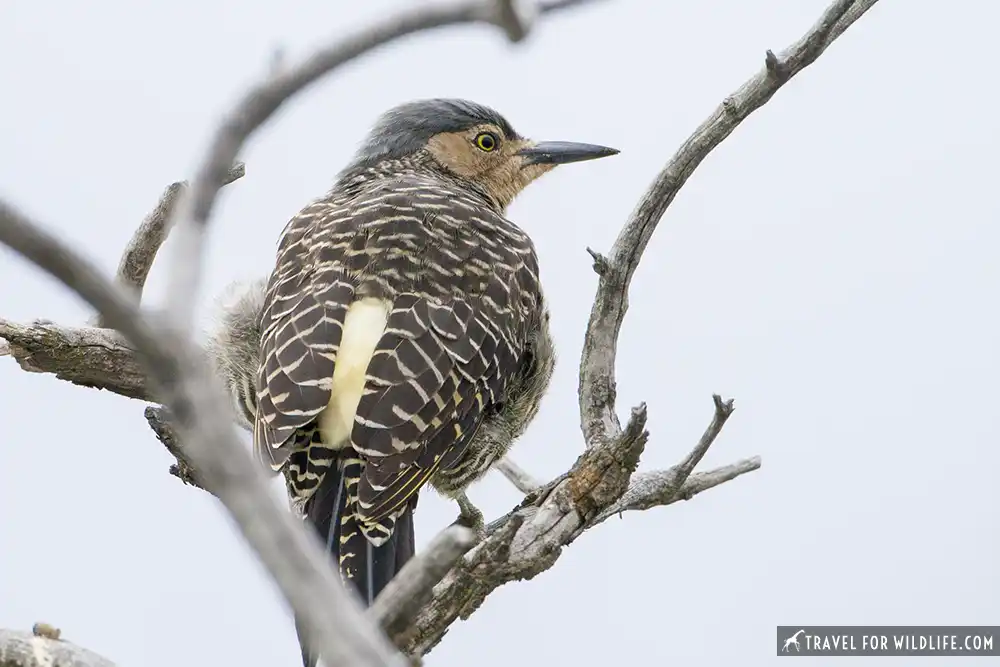
The Chilean flicker (Colaptes pitius) lives in beech forests. Easily identified by its barred wings and dull yellow rump. They feed on the ground and nest in tree cavities.
Where to see Chilean flicker: Torres del Paine National Park
Flightless steamer duck / Magellanic steamer duck
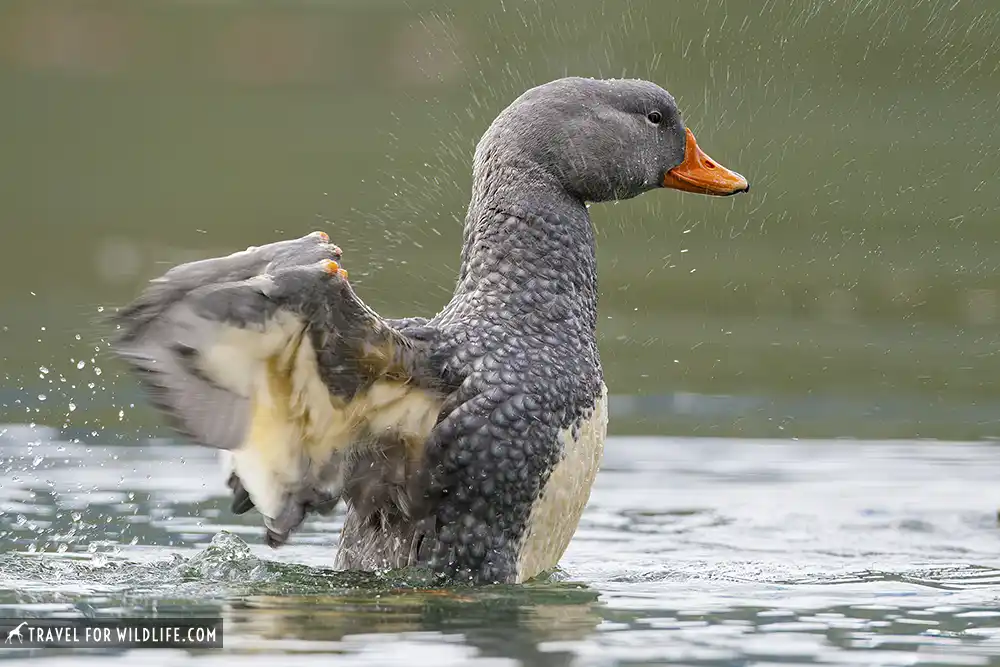
The flightless steamer duck (Tachyeres pteneres), also known as the Fuegian duck, is found along rocky coasts and not found on lakes. This large and heavy duck nests in heavy vegetation or in abandoned penguin burrows from September through December.
Where to see the flightless steamer duck: Tierra del Fuego National Park
Chimango Caracara
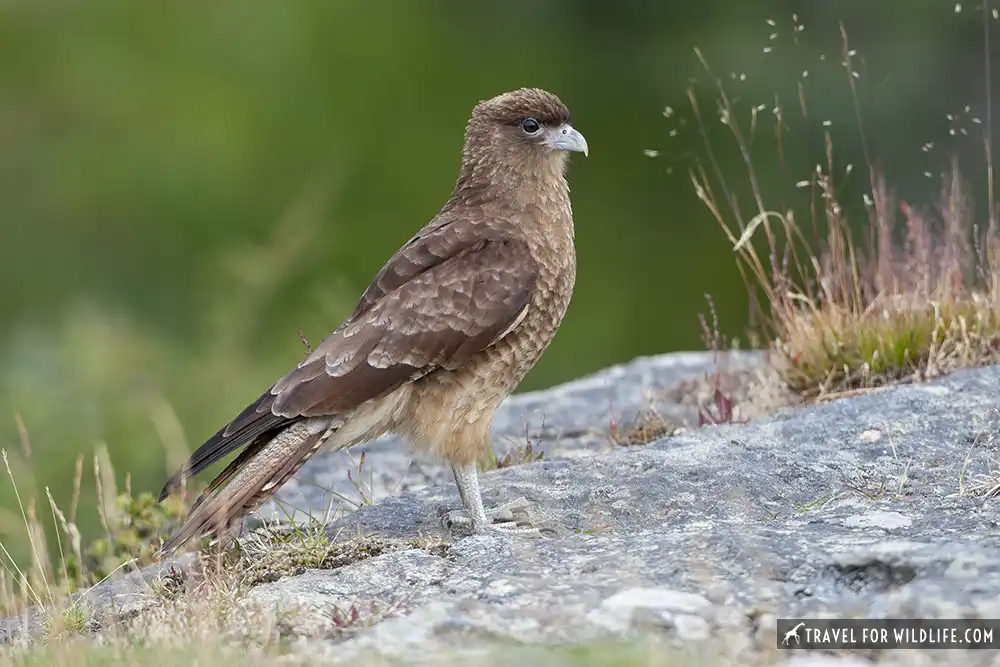
A year-round resident in its range, the chimango caracara (Milvago chimango) can be found all over Patagonia in all types of habitats, from shrubland to grassland, urban, open woodlands, and marshes. While males have yellow skin around the eyes and yellow legs and feet, females have pink reddish skin around the eyes and gray/blue legs and feet.
Where to see chimango caracara: Tierra del Fuego NP, Torres del Paine NP
Great Grebe
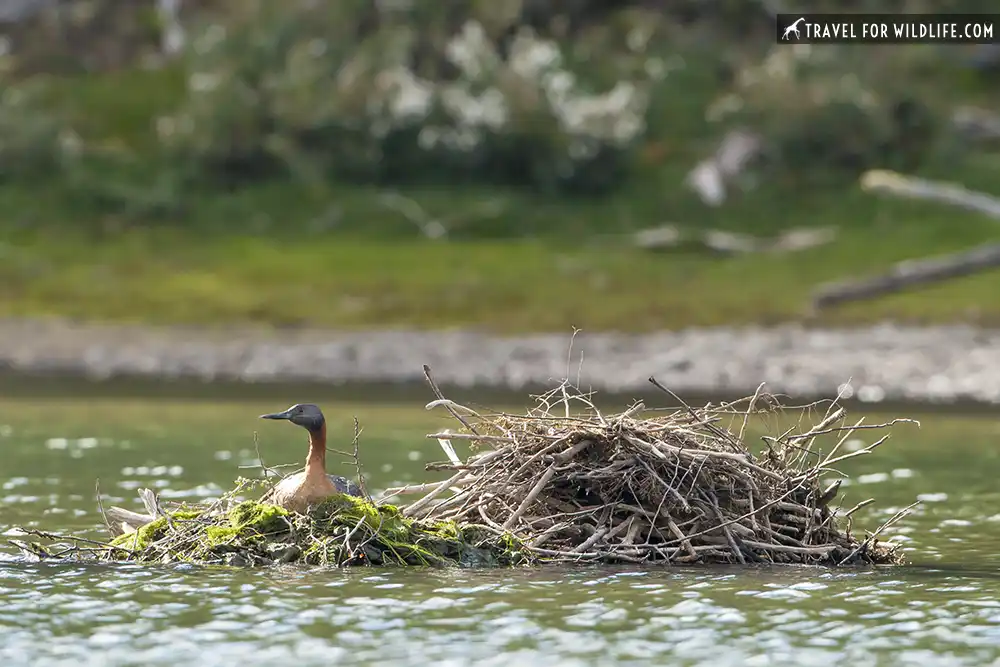
The great grebe (Podiceps major) is the largest species of grebe in the world and can weigh up to 4.4 pounds. It is found from southeastern Brazil to Patagonia to central Chile. Great grebes found in southern Chile and Argentina are considered a subspecies (Podiceps major navasi). Found in open waterways and estuary marshes.
Where to see great grebes: Tierra del Fuego NP
Grey-hooded Sierra finch
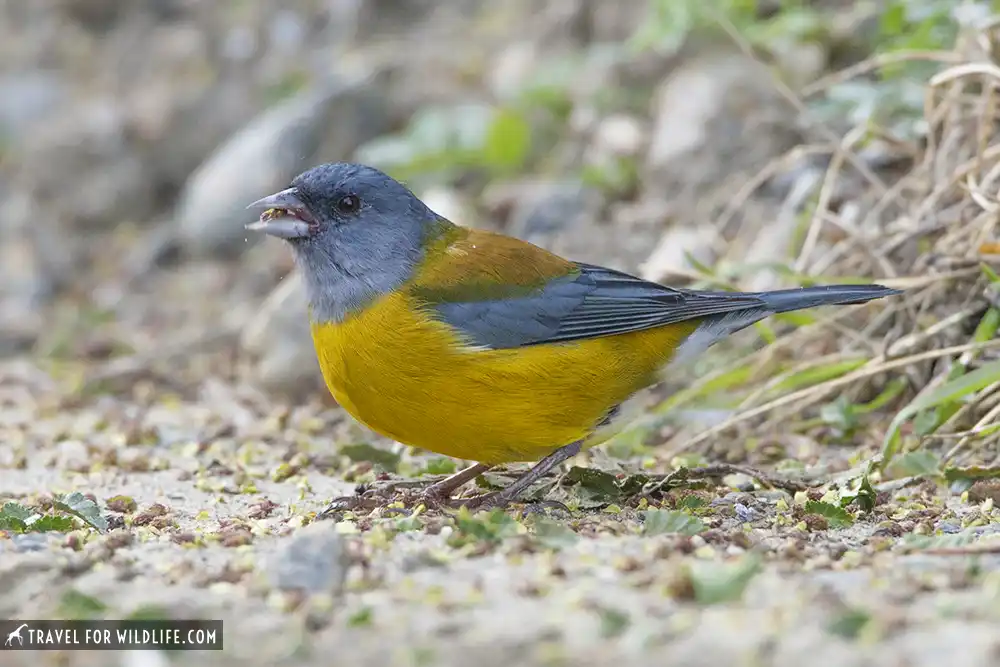
The grey-hooded sierra finch (Phrygilus gayi) is found in scrubby habitat. While the males are bicolor (dark grey hood and wings and greenish yellow body), females and juveniles have a whitish belly and dark whiskers.
Where to see grey-hooded Sierra finches: Tierra del Fuego NP
Spectacled Duck (or Bronze-winged Duck)
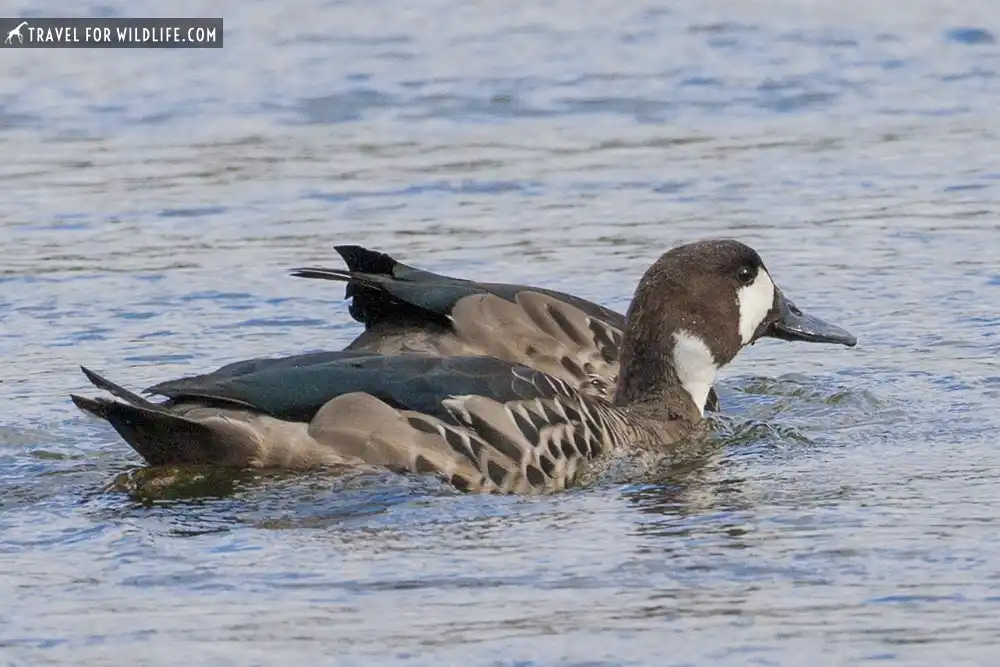
Identifiable by its bold white patch under the eye, the spectacled duck (Speculanus specularis) is found in lakes and ponds, but also near fast-flowing water. Their bronze wing panel is hidden when not in flight. Their old name was bronze-winged duck.
Where to see spectacled ducks: Torres del Paine NP, Tierra del Fuego, Ushuaia, Punta Arenas
Plumbeous Rail
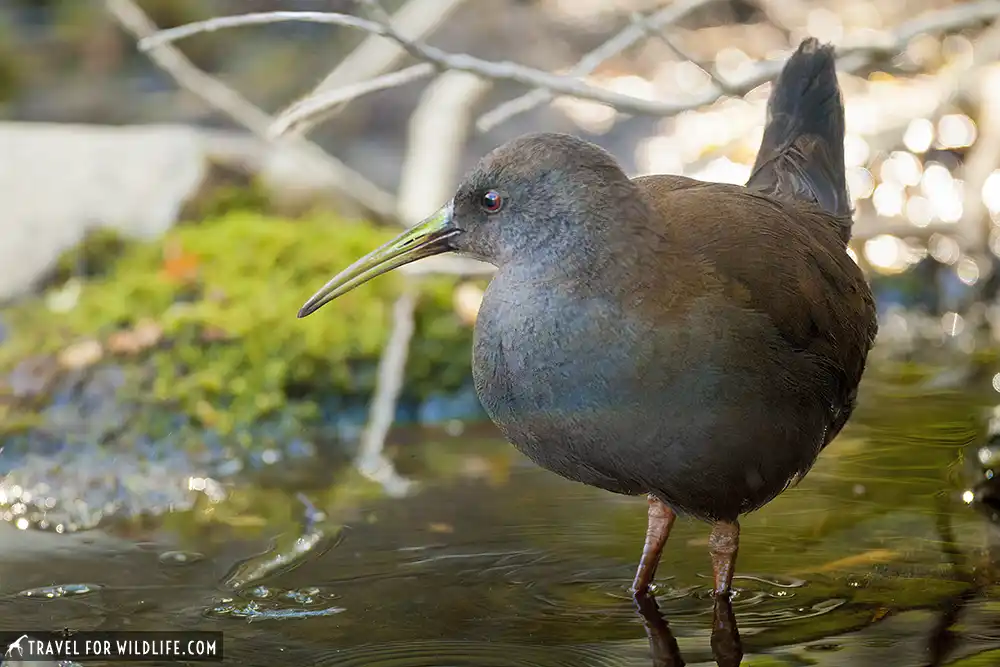
Found in marshes and ponds, the plumbeous rail (Rallus sanguinolentus) has a brown back and red eyes and legs. Their beaks are colorful, yellow with a red spot on the lower mandible and a blue spot on the upper mandible. Beaks are duller in juveniles, like the one in the photo.
Where to see the plumbeous rail: Tierra del Fuego National Park, Torres del Paine NP
Final thoughts on the birds of Patagonia
Patagonia is an incredible place for birdwatchers. With such an array of ecosystems, the diversity of Patagonian birds will make any nature enthusiasts happy. Get out and enjoy the birds of Patagonia!

Cristina Garcia
Zoologist and wildlife photographer. She has worked in the field with jackals, wolves, cheetahs, & leopards. She serves on the Board of Directors of SEE Turtles, a non-profit sea turtle conservation organization.
Read her posts at Travel For Wildlife and see more of her work at Truly Wild, & Our Wild Yard.


